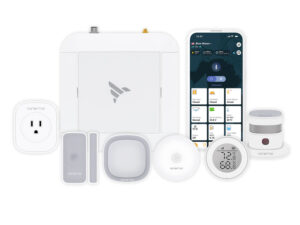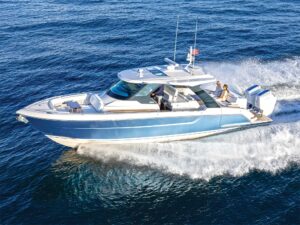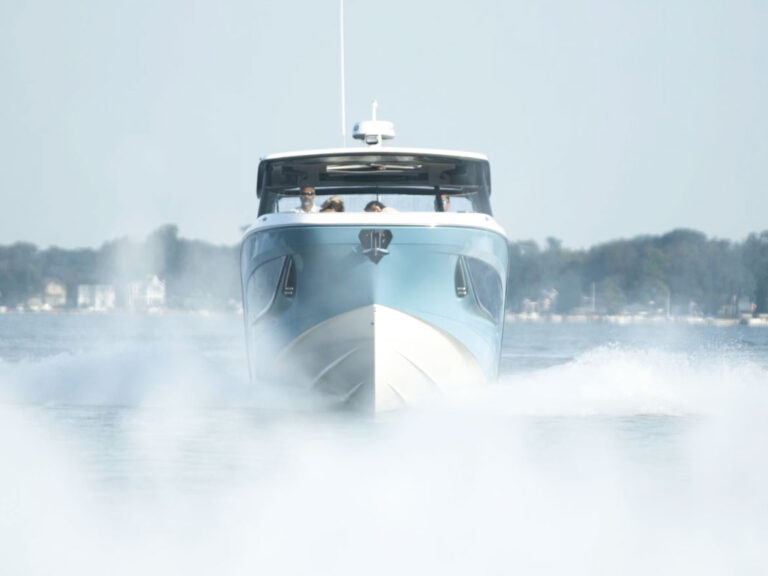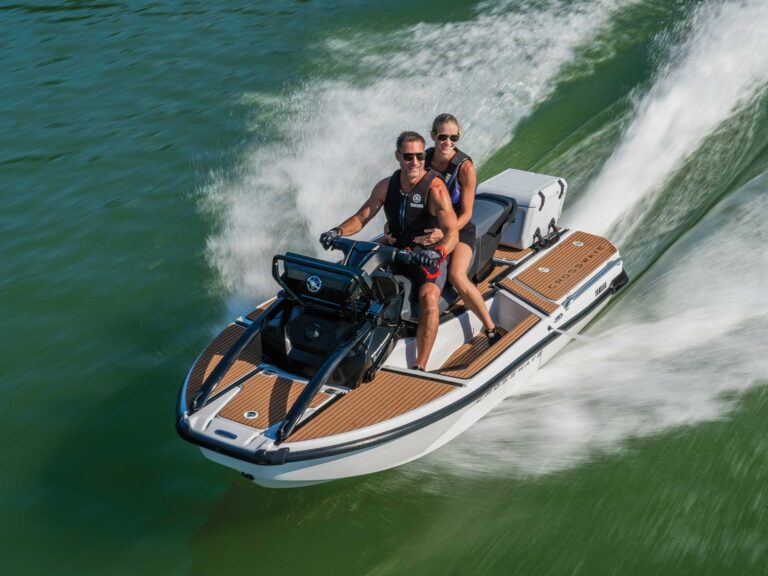Eventually, a boat’s gelcoat can’t be saved by a buffer with No. 2 polishing compound. Crazing cracks spread too far, and the base coat bleeds through the color coat. It’s time to paint.
Remember, you’ve got that crazy do-it-yourself gene too.
Two topsides paints are marketed to DIY boaters, and we put them to the test. Their descriptions are oddly similar but their mixing and thinning directions somewhat different.
Wet Edge
Pros work from the wet edge of the paint, which is the last brush or roller stroke laid down in the previous brush or roller load. Working from the stern, roll the paint forward in a “W” pattern. Tip horizontally with the brush from the last roller stroke to the first. This theoretically lays the paint down in a way that pulls the chemical binders and activators across the layer evenly and ensures they’ll bond to the previous paint area, eliminating the stipple that results from a roller-only job.
How We Tested
Instructions: We gave a score of three points for clear and proper detail in directions, but to earn that score, we downloaded online directions as well. Consider it mandatory.
Gloss and Sheen Test: We measured “inches of reflection” in direct sunlight using a black ruler with yellow marks: also known as depth of gloss.
Abrasion Resistance: These paints require a week to cure to full hardness — five days after our deadline, so check online for our abrasion scores.

Pettit
EZ Poxy2
$80; Pettitpaint.com
Clarity of Instructions: 3/3
Gloss and Sheen: 36 “inches of reflection”
We required three coatings to achieve coverage. The sheen improved steadily over a couple of days. New painters should practice thinning, technique and coating thickness on a sheet of melamine. Dark paint highlights imperfections in finish.
Product Touts: High gloss, two-part-catalyzed polyurethane enamel; abrasion resistant; chemical resistant; UV protected. For use on fiberglass, wood, steel, aluminum and epoxy. For above the waterline, except it may be immersed up to 48 hours.
Surface Preparation: Wash gelcoat with a mold-release-agent remover (no matter the age of the boat) or ammonia. Use primer to fair out small scratches and nicks. Sand from 220 to 320 grit. Wipe with thinner; then tack cloth to remove all dust.
Mixing and Components: Mix at 4:1 color to activator or both pouches to a quart, one pouch to a pint. Thin 5 to 10 percent in hot weather. Thin sparingly, test, and then add for proper flow.
Application Temperature Range: 50 to 90 degrees
Sandable In: 8 hours at 90 degrees; 16 hours at 70 degrees; 24 hours at 50 degrees
Sand When Recoating: Always sand lightly between coats at 320 grit, only enough to haze the surface and not thin color.
Priming: Sand substrate to 220 and then use EZ Prime to fair fine scratches; sand from 220 to 320 grit. Primer is mandatory on metals and wood and may improve adhesion on gelcoat.
Application: Use 3/16-inch-nap foam roller to apply very thin coats in a W pattern on flat surfaces (apply side to side in confined areas where a W pattern is not practical). Tip with foam brush. Avoid runs on horizontal surfaces by tipping along their length. Follow “wet edge” protocol.
Pot Life: 2 hours at 90 degrees; 3 hours at 70 degrees; 5 hours at 50 degrees
Ready to Splash In: 24 hours

Interlux
Perfection
$65; yachtpaint.com
Clarity of Instructions: 3/3
Gloss and Sheen: 36 “inches of reflection”
We achieved coverage in two coatings. Sheen deepened and leveled over two days. Mix any quantity from a few ounces to a quart or gallon. Test thinning mixture on melamine to match temperature and humidity. Light colors show fewer imperfections.
Product Touts: High gloss, two-part-catalyzed polyurethane finish; protection against ultraviolet light; abrasion resistant. For use on fiberglass, wood, steel, aluminum and epoxy above the waterline except for immersions less than 48 hours.
Surface Preparation: Wash gelcoat surfaces with a mold-release-agent remover: Fiberglass Solvent Wash 202 or Fiberglass Surface Prep YM8601V. Sand from 220 to 320 grit. Wipe down with thinner; remove dust with tack cloth.
Mixing and Components: 2:1 color to activator; thin 0 to 10 percent (less on cool days) using Brushing Reducer 2333N. Thin sparingly; let stand 20 minutes; test; then add for proper flow.
Application Temperature Range: 50 to 95 degrees
Sandable In: 12 hours at 95 degrees to 24 hours at 50 degrees
Minimum Recoat Time Without Sanding: 4 hours at 95 degrees to 24 hours at 50 degrees
Sand When Recoating: Sand (320 grit) if waiting more than 24 hours at 95 degrees or four days at 50 degrees.
Priming: Thin Epoxy Primekote 25 percent with Brushing Reducer 2333N before mixing with activator at 3:1 ratio. Sand from 220 to 320 grit. Required on metal and wood, helpful on gelcoat.
Application: Use 3/16-inch-nap foam roller to apply two very thin coats in a W pattern on flat surfaces (apply side to side in confined areas where a W pattern is not practical). Tip with foam brush. Beware of horizontal structures that cause drips. “Wet edge” protocol is optional, according to Interlux.
Pot Life: 1 hour at 95 degrees to 4 hours at 50 degrees
Ready to Splash In: One to four days









